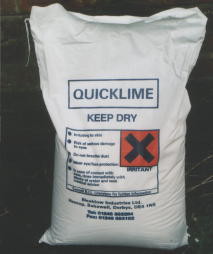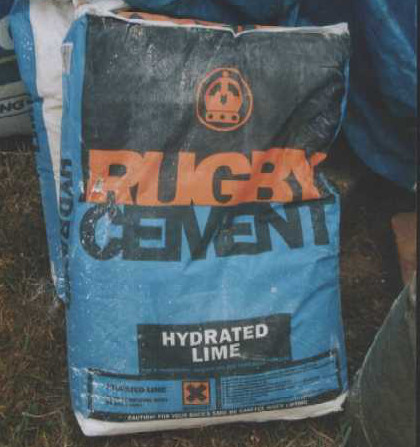Different types of lime
Non-hydraulic lime (quicklime), hydrated lime, hydraulic lime and lime sand.
Non-hydraulic lime (quicklime)
- Made from limestones containing at least 95% CaCO3. The higher the percentage of CaCO3, the purer or ‘fatter’ the lime is said to be.
- CaCO3 is burnt at around 900°C, and carbon dioxide is driven off, leaving quicklime, or calcium oxide (CaO), a white powder.
- Then water is added to the quicklime to ‘slake’ it, which produces lime putty – calcium hydroxide – Ca(OH)2.
- When lime putty is exposed to the air it sets, or carbonates, by re-absorbing CO2 from the air – ie it becomes calcium carbonate again – but this time on your building, or between your bricks!
- But it needs to be exposed to the CO2 in air to set. There are stories of Roman ruins being excavated, and the lime mortar in the middle of thick walls was found to be un-set after 2000 years! As soon as it was exposed to the air it began to go off.
- See ‘environmental benefits’ for more on the chemical reactions involved.
- Non-hydraulic lime is the most permeable of all limes, and the best for old buildings. this is the lime we will be talking about most. In fact we recommend non-hydraulic lime for pretty much everything on the domestic scale, as the more hydraulic a lime gets, the less it benefits the environment (see later). We’d recommend you use hydraulic lime only for areas that are more or less permanently damp.

Hydrated lime
- This is the ‘bag’ lime that you can buy from any builders’ merchants.
- Calcium hydroxide.
- Added to cement mortars to increase workability, flexibility, and to increase drying time to avoid cracking.
- Quicklime is slaked with a small and precise amount of water, which is driven off by the heat of the reaction, leaving a powder.
- Fast degrading – can carbonate in the bag.
- It can be made into a lime putty, like making a white sauce by adding water slowly – best to leave to soak for a week.
- However, it doesn’t carbonate as well, and so it’s not so durable, and not so good for the environment; it is mainly used as a cement additive.

Hydraulic lime
- Produced from limestones containing clay (or clays added during manufacture).
- Sets when calcium combines with silica and alumina in clays to produce calcium silicates and calcium aluminates.
- Can also set by carbonation, but doesn’t have to, so ideal for damp conditions; can set underground, or even underwater!
- Usually supplied in powder form – not usually putty like non-hydraulic. Hydraulic lime putty can be made, but as it doesn’t need CO2 to set, it can use the clay impurities to set in the tub after a few days. So if it’s in putty form, it has to be used straight away (or at least within a couple of days). However, you will almost always find it in powder form. Eminently hydraulic lime will never be found in putty form, as it sets too quickly.
- Sets harder than other limes – and the more clay it contains, the harder it sets.
- Sets more quickly than other limes.
- So – the more clay content, the more it behaves like cement.
- At c. 40% silica/alumina – maximum strength, but minimum CO2 absorbtion.
- Hydraulic lime was found to be very useful in damp conditions, and in the construction of dams, bridges, quays etc.
- Experiments with hydraulic lime, adding various amounts of different clays, led to the invention of Portland cement.
- It is perhaps better to sometimes use hydraulic limes for mortars in thick walls because they will set without contact with the air, and also for damp places, or situations where extra strength is important. Non-hydraulic limes are better for plasters and renders (and in most cases are fine for mortars as well – especially as you can use pozzolanic additives in thick walls).
- You can choose the most suitable lime for your particular conditions:
- Feebly hydraulic lime contains less than 12% clays, comes as an off-white powder, and is sticky and easy to use. It sets underwater in around 20 days.
- Moderately hydraulic lime contains between 12% and 18% clays, comes as a pale grey powder, and is less sticky and less easy to use. It sets underwater in 15-20 days.
- Eminently hydraulic lime contains more than 18% and up to 40% clays, and produces a crumbly mortar that is difficult to use. In any conditions there will be an initial set in a couple of hours, and it will be completely hard in a couple of days.
- Probably best to only use hydraulic limes in places that are constantly damp. On the domestic scale, non-hydraulic is perfectly adequate, and remember that the more hydraulic a lime is, the less it needs to take CO2 from the atmosphere to set, thus negating the most important environmental benefit of using lime.
Lime sand
- Waste from ground limestone.
- Fine grade used by farmers – the agricultural lime spread on land to increase pH.
- It can be used as a sand fraction of mortars.






